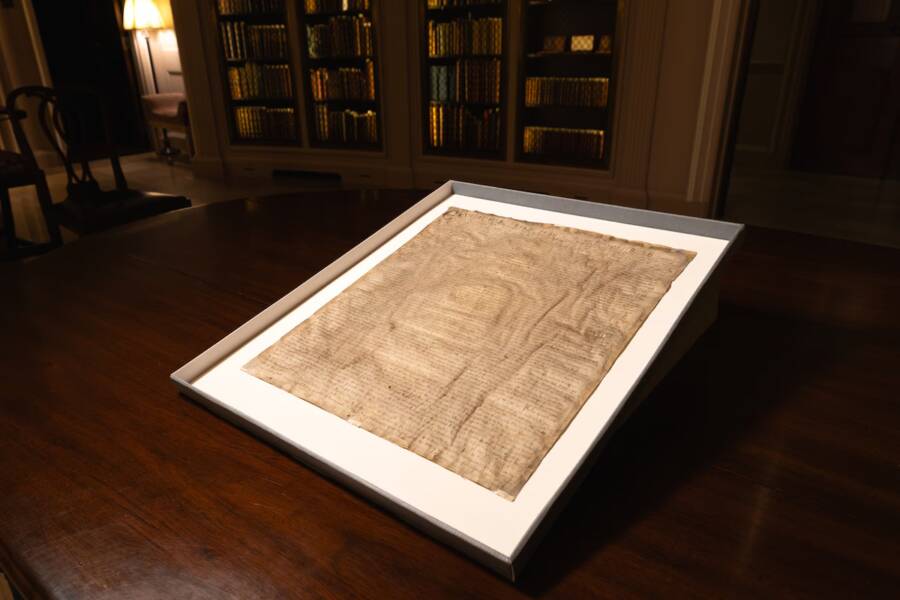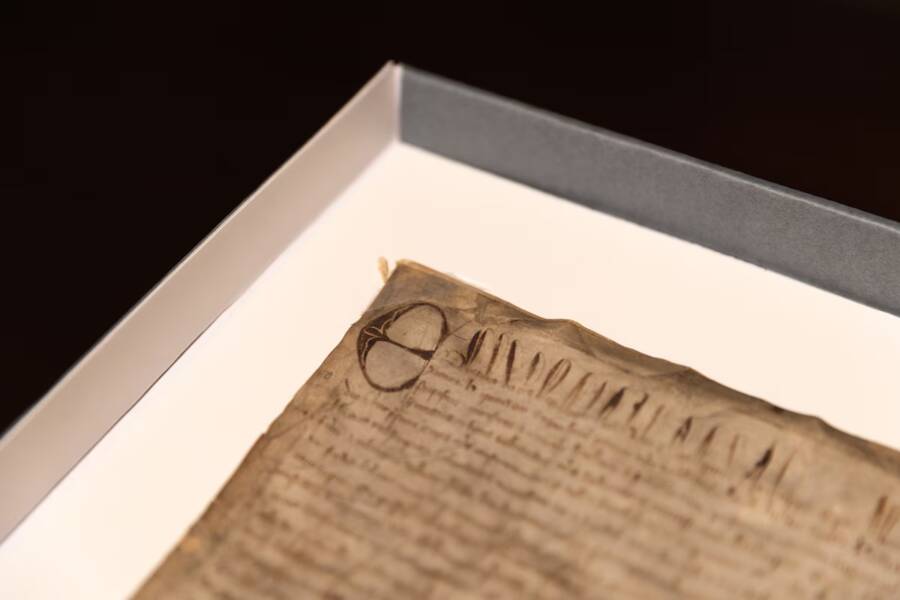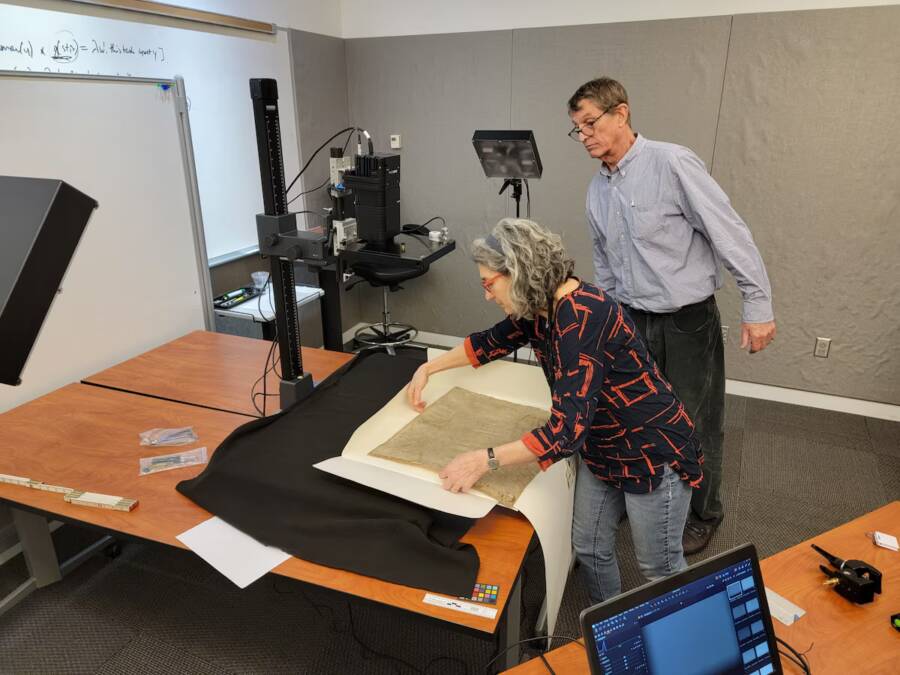Purchased for just $27.50, this document was believed to be a mere replica, but a medieval history professor searching Harvard's archives recently determined that it's actually an original Magna Carta issued by King Edward I.

Lorin Granger/Harvard Law SchoolThe Magna Carta found at Harvard University was consistent with other originals issued by King Edward I.
In 1946, Harvard University purchased what it believed to be a replica of the Magna Carta, the historic document signed by King John of England in 1215 that limited the power of the monarchy and established that no man was above the law. At the time, the university paid $27.50 (around $462 today) for the document, and it had been sitting in their archives ever since.
However, British researchers recently discovered that Harvard’s Magna Carta was no mere copy, but rather an original issued by King Edward I in 1300 — one of just seven that have survived to the present day.
In a statement released by the university, David Carpenter, the professor of medieval history at King’s College London who made the discovery, called this newly rediscovered Magna Carta “one of the world’s most valuable documents.”
“This is a fantastic discovery,” Carpenter said. “Harvard’s Magna Carta deserves celebration, not as some mere copy, stained and faded, but as an original of one of the most significant documents in world constitutional history, a corner stone of freedoms past, present and yet to be won.”
Why The Magna Carta Is One Of The Most Important Documents In History

Lorin Granger/Harvard Law SchoolThe large “E” as well as other features of this document were characteristic of all the other originals from 1300.
The Magna Carta, or “Great Charter,” was signed by King John of England on June 15, 1215, at Runnymede, a meadow by the River Thames. The document effectively served as a peace treaty between the king and a group of rebellious barons who had felt the king was behaving like a tyrant. King John’s rule had been plagued by heavy taxation, arbitrary justice, and military failures, which sowed discontent among his people.
The Magna Carta was a written agreement that attempted to limit the powers of the monarchy and assert that the king, like anyone else, was subject to the law. It was a radical idea for the time, of course, given that kings had long been considered to have divine right and to only be accountable to God.
The document contains 63 clauses addressing various grievances, including protection of church rights, access to swift justice, and limitations on feudal payments to the Crown. One of its most famous clauses, for instance, states: “No free man shall be seized or imprisoned, or stripped of his rights or possessions… except by the lawful judgment of his equals or by the law of the land.”
As the Magna Carta established foundational principles of law and due process, it inspired the development of constitutional law in England. Naturally, it also heavily influenced foundational documents like the United States Constitution and the Bill of Rights. It’s little wonder why the document is still so fascinating to historians in the modern age.
Professor David Carpenter just so happened to be one of those scholars deeply fascinated by the Magna Carta. So, as he was studying unofficial copies of this document, he came across the digitized version of the one belonging to Harvard, dubbed HLS MS 172.
That’s when he made his remarkable discovery.
Researchers Identify Harvard’s Magna Carta As An Original From 1300

M.B. Toth/R.B. Toth AssociatesThe Harvard Magna Carta being prepared for multispectral imaging.
Comparing the digitized HLS MS 172 with other originals, Carpenter quickly began to suspect that he was not looking at a replica. He contacted Professor Nicholas Vincent, another medieval history professor at the University of East Anglia, to help with his investigation.
When Harvard University acquired the document in 1946, it was told that the alleged copy had been dated to 1327 — still quite old, but given how many copies of the document exist, nothing all that special. But Carpenter and Vincent said they both immediately recognized that HLS MS 172 was no mere copy.
“The instant I saw it, I knew!” Vincent told The Washington Post. “Everything about the document looked right. The layout, the text, the handwriting, and the large capital E for Edwardus.”
The Magna Carta was reissued several times throughout the 13th and 14th centuries. King John reissued it himself in both 1216 and 1217, and then his son, King Henry III, had the Great Charter reissued in 1225. Henry’s son, Edward I, then reissued it in 1297 and 1300.
The Harvard Magna Carta just so happened to be one among the batch reissued by Edward I in 1300.

Wikimedia CommonsKing Edward I, the man who issued the copy of the Magna Carta that was recently rediscovered at Harvard.
It’s believed to be the 24th original overall, and just one of seven originals issued by Edward I in 1300. Researchers determined that the document’s dimensions are consistent with the six other known originals issued that year, as is the handwriting. Scribes of the 1300 Magna Carta were given strict instructions in how they printed, so any variation from those guidelines would indicate a copy — but HLS MS 172 didn’t feature any variations.
“The provenance of this document is just fantastic,” Vincent said. “Given where it is, given present problems over liberties, over the sense of constitutional tradition in America, you couldn’t invent a provenance that was more wonderful than this.”
Carpenter described the discovery as “almost providential,” given Harvard University’s current legal battles against the Trump administration regarding student protests concerning the Israel-Gaza conflict.
The university’s president, Alan Garber, has remained steadfast in his conviction that the government should not dictate what universities teach, which students they admit, or which teachers they hire. In response, the Trump administration terminated $450 million in federal funding to the university.
Vincent summarized why the Magna Carta has been so foundational, describing it as “a totem of liberty, central to our sense of who we are: a freedom-loving, free-born people.”
“Magna Carta says the ruler is subject to law,” Carpenter said. “The ruler can’t just say, ‘Off with your head.’ He can’t just take your land, but must follow the laws, too.”
After learning about how researchers identified this original Magna Carta in Harvard’s archives, learn about the messy history behind who wrote the Bill of Rights. Then, read about when the Constitution was written — and why the answer isn’t so clear.





